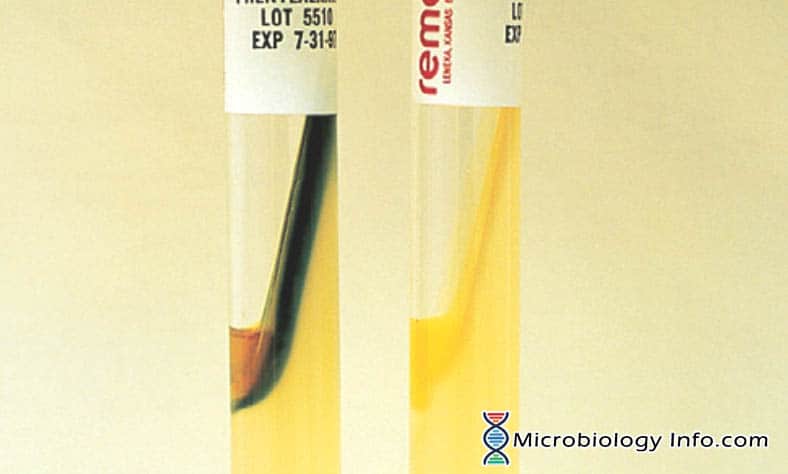Biochemical tests are the tests used for the identification of bacteria species based on the differences in the biochemical activities of different bacteria. Bacterial physiology differs from one type of organism to another. The differences in carbohydrate metabolism, protein metabolism, fat metabolism, production of certain enzymes, ability to utilize a particular compound etc. help them to be identified.
On such test is the the phenylalanine agar test which tests for the ability of some specific species to convert amino acid phenylalanine to phenylpyruvic acid; an important reaction in the differentiation of Enterobacteriaceae. Based on this criterion, the test is carried out for the differentiation of Proteus and Providencia group from other members of Enterobacteriaceae which lack such an activity.
Objective
To determine the ability of an organism to oxidatively deaminate phenylalanine to phenylpyruvic acid.
Principle
Phenylalanine agar, also known as phenylalanine deaminase medium, contains nutrients and DL-phenylalanine. The phenylalanine serves as the substrate for enzymes, which are able to deaminate it to form phenylpyruvic acid. Yeast extract in the medium supports the growth of the organisms. Sodium chloride maintains osmotic equilibrium.
Microorganisms that produce phenylalanine deaminase remove the amine (NH2) from phenylalanine. The reaction results in the production of ammonia (NH3) and phenylpyruvic acid. The phenylpyruvic acid is detected by adding a few drops of 10% ferric chloride which acts as a chelating agent ; a green colored complex is formed between these two compounds indicating a positive test. If the medium remains a straw color, the organism is negative for phenylalanine deaminase production.
Media:
Phenylalanine (2 g), yeast extract (3 g), NaCl (5 g), Na3PO4 (1 g), agar (12 g), per 1000 mL, pH 7.3.
Method
- Using a loopful of inoculum from an 18-24 hour pure culture, streak the slant surface using a fishtail motion or inoculate phenylalanine slant with 1 drop of a 24-hour brain-heart infusion broth.
- Incubate the inoculated slant aerobically at 35ºC. for 18-24 hours.
- Following incubation, apply 4-5 drops of a 10% Ferric Chloride solution directly to the slant.
- Gently agitate the tube and observe for the development of a green color within 1-5 minutes.
Expected Results
- Positive: Green color develops on slant after ferric chloride is added within 1-5 minutes after applying ferric chloride reagent.
- Negative: Absence of a green color reaction. Negative results will take on a yellow color due to the color of the ferric chloride.

Uses
It is recommended for use in the differentiation of gram-negative enteric bacilli based on the ability of the microorganisms to produce phenylpyruvic acid by oxidative deamination. The genera Morganella, Proteus, and Providencia can be differentiated from other members of the Enterobacteriaceae family.
Limitations
- It is recommended that biochemical, immunological, molecular, or mass spectrometry testing be performed on colonies from pure culture for complete identification.
- The green color reaction of a positive test fades rapidly. Test results must be interpreted within 5 minutes following the application of ferric chloride or false-negative results may occur.
References
- Tille, P. M., & Forbes, B. A. (2014). Bailey & Scott’s diagnostic microbiology (Thirteenth edition.). St. Louis, Missouri: Elsevier.
- Koneman, E.W., et al. Color Atlas and Textbook of Diagnostic Microbiology, J.B. Lippincott Company, Philadelphia, PA.
- https://catalog.hardydiagnostics.com/cp_prod/Content/hugo/CRITN-PhenylalanineAgar.html
- himedialabs.com/TD/M281.pdf
- www.austincc.edu/microbugz/phenylalanine_deaminase_test.php
- https://assets.fishersci.com/TFS-Assets/MBD/Instructions/IFU62180.pdf
Similar Posts:
- Lysine Iron Agar (LIA) Slants Test – Procedure, Uses and Interpretation
- The Triple Sugar Iron (TSI) Test – Principle, Procedure, Uses and Interpretation
- Kligler’s Iron Agar Test – Procedure, Uses and Interpretation
- Oxidase Test- Principle, Uses, Procedure, Types, Result Interpretation, Examples and Limitations

will the PKU gel taken daily effect the results?